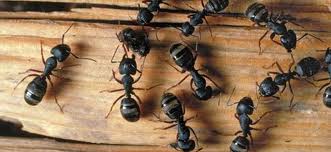Many pest control professionals and homeowners alike agree that ants are the most difficult insect pests to control within and around residential and commercial structures. There are several reasons for this, including the ability of most ant pest species to establish multiple nests within hidden indoor locations, such as wall voids, ceiling voids, and even woodwork. Eliminating an ant infestation requires the destruction of all ant nests associated with the offending colony, which usually includes the nearly impossible task of pinpointing several indoor and outdoor nesting sites.
Even ant pest species that nest solely outdoors but occasionally enter homes for food, water and/or shelter are also very difficult to control, as most ant species maintain a cryptic habitat within ground soil where they cannot be observed, much less destroyed. While no ant pest is easy to control, ant species that are native to the area in which they are found are generally less difficult to control than non-native ant species that thrive in regions where they are not native. This latter group of non-native ant species are known as “invasive” pests, and several invasive ant species regularly infest Massachusetts homes.
There exists several invasive ant species in the US, the most notable of which is arguably the red-imported fire ant, which is a medically significant pest found solely in the southern states. Invasive ants that are known to infest Massachusetts homes include Pharaoh, ghost, and longhorned crazy ants. The dangerous Asian needle ant and a close relative of the pavement ant, Tetramorium tsushimae, are two invasive ant pests that have established colonies in certain residential areas in multiple northeastern states, but neither have been found in Massachusetts.
The European fire ant (Myrica rubra) does not meet the criteria of an invasive pest because its invasive US habitat range has not expanded beyond New England since they were first discovered in Massachusetts over a century ago. However, this potentially harmful ant species possesses some characteristics in common with invasive ants, such as their habit of readily establishing multiple nests in a variety of confined conditions and the existence of multiple queens within single colonies. Like invasive ants, the European fire ant’s ability to rapidly establish numerous nests in a variety of conditions is why they are frequently transported to new regions within mulch and other plant materials. The existence of multiple queens per colony allows new colonies to be established by queens that leave existing colonies. This makes the dispersal and establishment of new ant colonies by means of annual mating swarms unnecessary for invasive ants.
Have you ever encountered European fire ants on your property?

